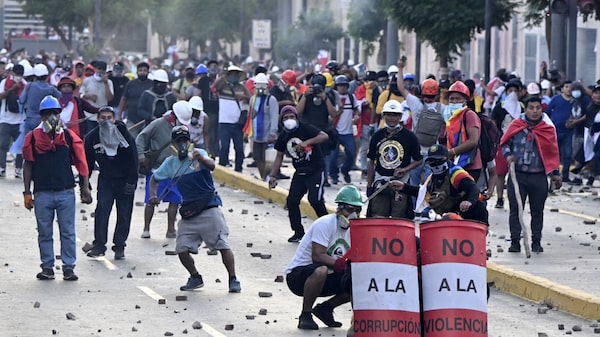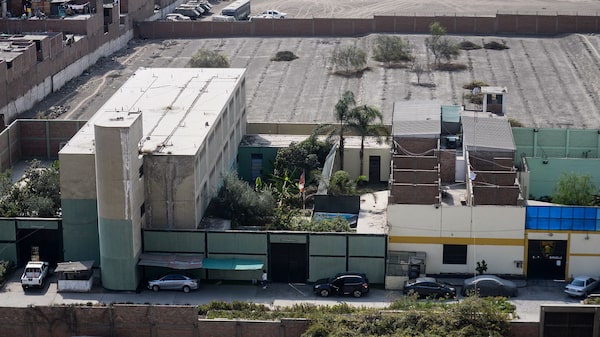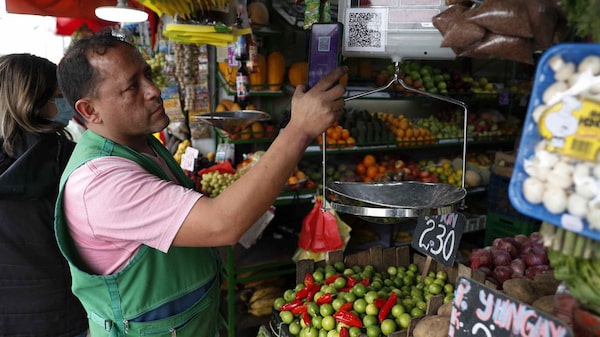Bloomberg — Through 16 years of impeachments and scandal, Julio Velarde, Peru’s central bank’s president, has presided over a remarkably resilient economy. But the country’s constitution now threatens to undo those achievements.
That constitution, pushed through by former president Alberto Fujimori, helped save Peru’s economy from collapse in the 1990s. But it also came with a perfect recipe for ungovernability, allowing Peru’s congress to impeach presidents with few speed bumps, while also empowering the president to dissolve congress almost on a whim.
The result: Since 2016, Peruvians have lived through six presidencies, six impeachment trials, one congressional dissolution and one failed coup. Three of their former leaders are in jail, on allegations ranging from rebellion to graft. Over Peru’s first 179 years, it saw zero impeachment trials. Since 1993, there have been seven.
“These rules of the game need to change,” Velarde said in a rare interview. “But how do you do that? In one case congress loses some of its power, in the other case the president loses some power.”
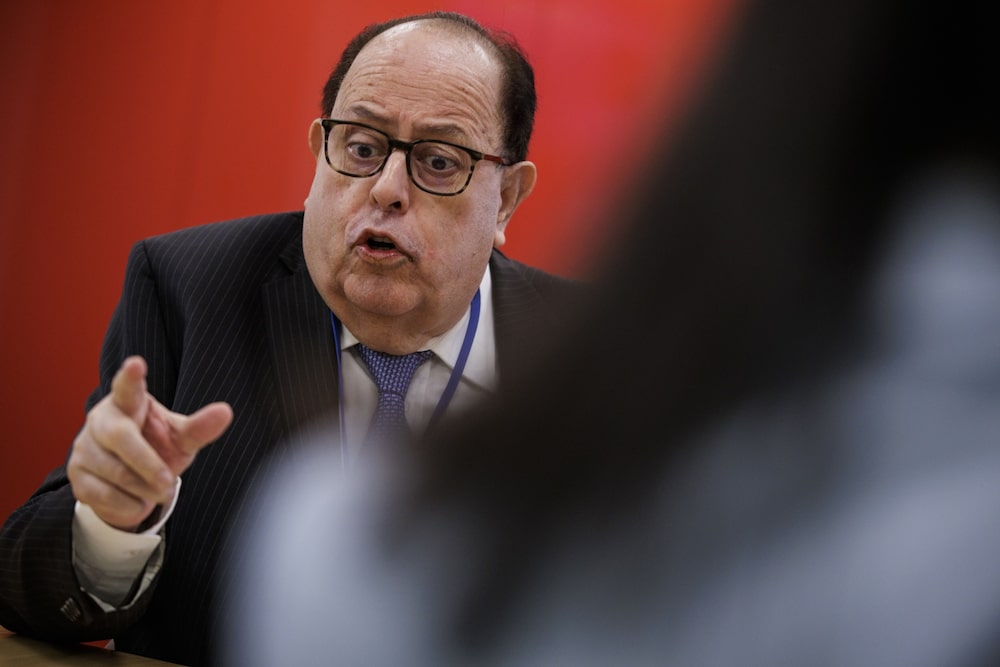
The worry is that without an overhaul of Peru’s political system, it’s getting harder to attract investment for industries that are vital to Peru and the global economy, from copper to blueberries.
Six months to the day after former Peruvian President Pedro Castillo attempted to illegally dissolve congress before being impeached and arrested, that toll is clear.
The ensuing political volatility led to dozens of deaths and Peru’s first economic contraction since the pandemic. As Peruvians boycotted the economy in an attempt to force the resignation of Castillo’s successor, human rights organizations say security forces engaged in extrajudicial executions in an attempt to quash the unrest and restart the economy.
Economic growth has slowed to a trickle after booming for much of this century. Investment in the construction of new mines is at a multi-year low and Peru is expected to lose its title as the world’s No. 2 copper producer by 2027. Mass anti-government protests wrecked the economy earlier this year. Peru’s economic success earlier this century did not prevent its underfunded public health system from shattering during the pandemic, leading to the worst per capita death rate worldwide. Over 1 million more Peruvians are now living in poverty than a decade ago.
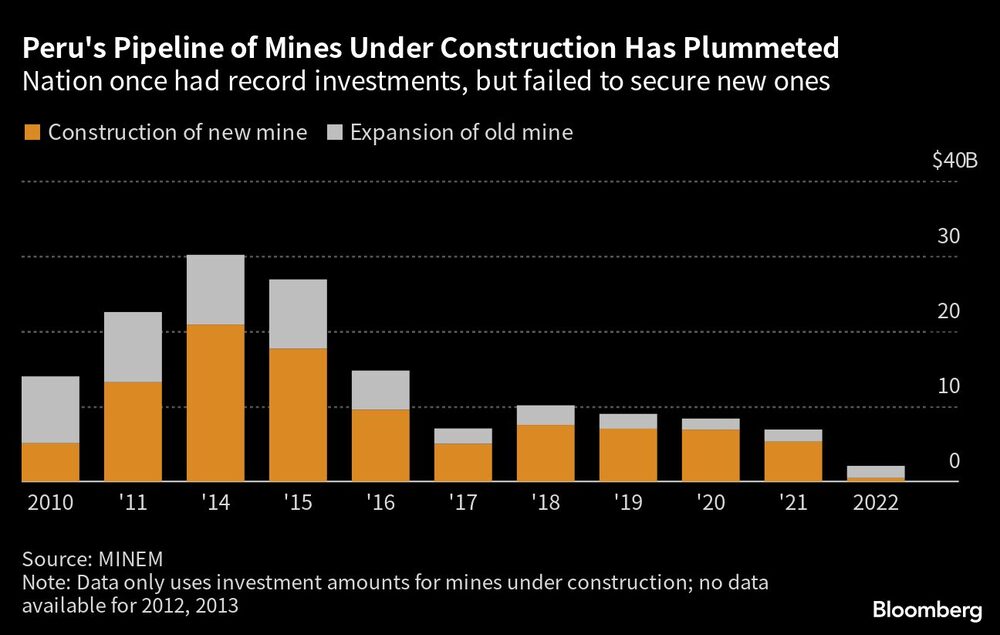
Peru’s woes offer a warning for Latin America, where impeachment attempts have grown more common from Chile to Ecuador to Paraguay. No country has experienced Peru’s cathartic presidential turnover. But its experience suggests that political instability can come at a cost for the economy and the most vulnerable.
Mirtha Vasquez, who served as Peru’s head of congress in 2020 and prime minister in 2021 called the country “ungovernable” — a crisis with increasingly tangible economic consequences. In the wake of mass protests against President Dina Boluarte In a country that loves to give it heads of state the boot, there’s no telling how long she’ll last.

‘A scream in the desert’
In 1992, Alberto Fujimori, two years into a ten-year presidency, ordered the military to shut down congress and the judiciary, after accusing lawmakers of stalling crucial reforms. In an illegal-but-nonetheless-popular power grab, he declared he would rule by decree and rewrite the constitution.
Later that year, he won a majority in the new constituent assembly. That new congress soon got to work on a new constitution shaped by Fujimori’s vision: remaking the political system.
Before 1992, Peru’s 180-seat house of representatives and 60-seat senate had to agree on the terms of impeachment before booting the head of state. But under Fujimori’s constituent assembly, lawmakers did away with the senate.
What this meant for impeachment: In Peru’s post-senate reality, firing a president would require only a single vote in the new unicameral parliament. Removal required a simple majority (This was amended to two-thirds after Fujimori’s own dramatic impeachment in 2000.) The new constitution did retain one key feature of its predecessor: lawmakers only had to decide if a president had shown “permanent moral incapacity.” Whatever that meant was up to lawmakers to decide.
The new constitution also set the president on a collision course with congress. Under the old constitution, the president could dissolve the lower chamber of congress, following three successful no-confidence votes in the same house. The new constitution lowered the threshold to two votes, which, the president could call at his discretion. Because the new system featured only one house, this meant that dissolving the lower house effectively meant dissolving the entirety of parliament. Fujimori had dissolved parliament in 1992, albeit illegally—now, congress had made it legal.
“These were nuclear weapons that were not meant to be used,” Velarde said.
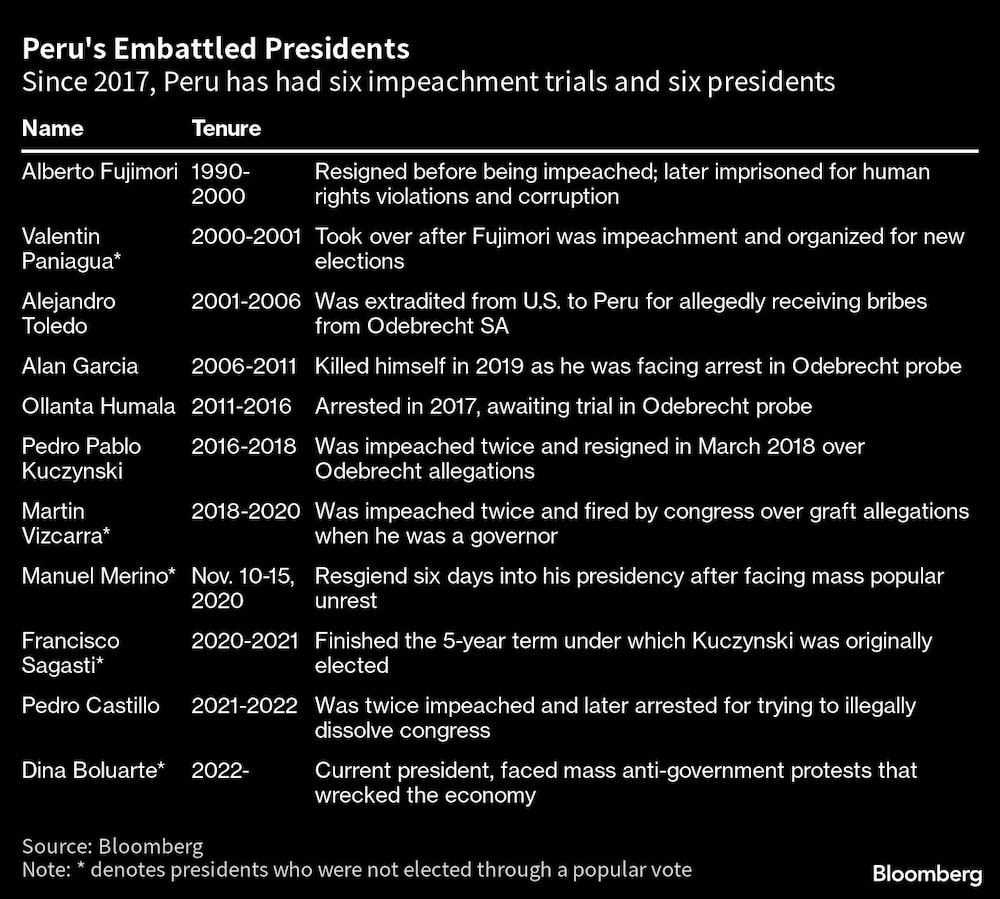
Some lawmakers tried to warn against consolidating the legislative branch and streamlining impeachment. “When you are left without congress….we are left before a dictatorship,” Jorge Donayre Lozano, a member of the opposition in congress, warned in 1993. With Fujimori, who would be impeached and jailed for human-rights violations, in control of the constituent assembly, Donayre Lozano said he knew his words would “be lost like a scream in the desert.”
Peru’s economic turnaround likely helped drown him out. In addition to its political overhaul, Fujimori’s constitution drastically reduced the state’s role in the economy. It privatized many state-owned corporations in sectors like oil and mining, whose losses had been a huge drag on tax coffers. By 1994, Peru’s economic growth had reached double digits. The country issued a new currency and inflation was in freefall. Between 1993 and 2015, the economy grew faster, on average, than it did from 2016 to 2019, when political turmoil started until just before the pandemic caused its own recession.
Experts across the political spectrum agree that the pro-market reforms in Fujimori’s constitution saved the country. “That is one of the few issues where there is unanimity in this country,” Luis Miguel Castilla, a former finance minister, told Bloomberg News.
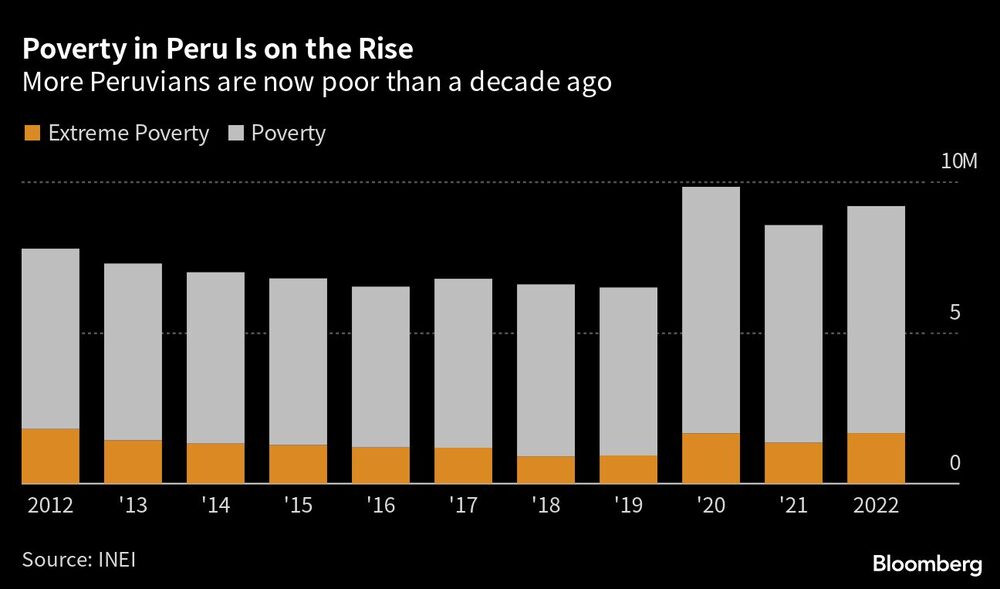
‘Pardon him, che,’
In 2017, Pedro Pablo Kuczynski became the first president to feel the sting of Peru’s ungovernability.
On the strength of his Wall Street experience, Kuczynski won the presidency in 2016 by 0.2 percentage points over Keiko Fujimori, Alberto’s daughter and the leader of the opposition-held Congress. It soon fired Kuczynski’s education and economy ministers, and in December of 2017, a group of Keiko-led lawmakers initiated impeachment proceedings against the president, alleging he had done business with Odebrecht SA, a construction company known for bribing political leaders across Latin America. Kuczynski acknowledged a company of his had done business with them, but denied any involvement. Whatever the truth—the constitution was not on his side.
With his fate hanging in the balance, Kuczynski told Bloomberg the notion of pardoning Alberto—an apparent quid pro quo in exchange for nixing his impeachment—crossed his mind. He said he had previously consulted Pope Francis on the possibility. “I said, ‘Your Holiness what do you think?’ Kuczynski recalled. “‘Pardon him, che,’” the Argentine Pope replied, using a word that translates to “dude,” Kuczynski said. (The Vatican did not respond to a request for comment.)

Kuczynski would be saved by a faction of Fujimoristas who, in a surprise turn, saved him by throwing their support behind him in the impeachment vote on Dec. 21. On Christmas Eve, Kuczynski set Fujimori free. (A Peruvian court would later revoke Fujimori’s pardon after finding it illegal.) Three months later, lawmakers tried again to impeach Kuczynski, alleging his relationship with Odebrecht went deeper than previously believed. In March 2018, he stepped down.
Kuczynksi’s successor, Martin Vizcarra, didn’t fare much better. In 2019 he dissolved congress, appearing to win a standoff over a slate of judicial appointments. But new lawmakers impeached and fired him in 2020. His successor lasted just six days on the job, due to massive unrest.
Kuczynski said he regrets not dissolving congress, which would have avoided his impeachment. But he doesn’t think presidents should have such power or that congress should have the power to “to fire a president without a proper impeachment process.” His dealings with Odebrecht are now the subject of a money laundering investigation.
‘Completely cuckoo’
Since Kuczynski became president, the average tenures of the top three ministers—prime minister, finance minister and mining minister—have halved. From 2001 to 2016, an era of historic expansion for Peru’s copper production, Peru’s mining ministers served an average tenure of 11 months; since 2016, it has shrunk to five months.
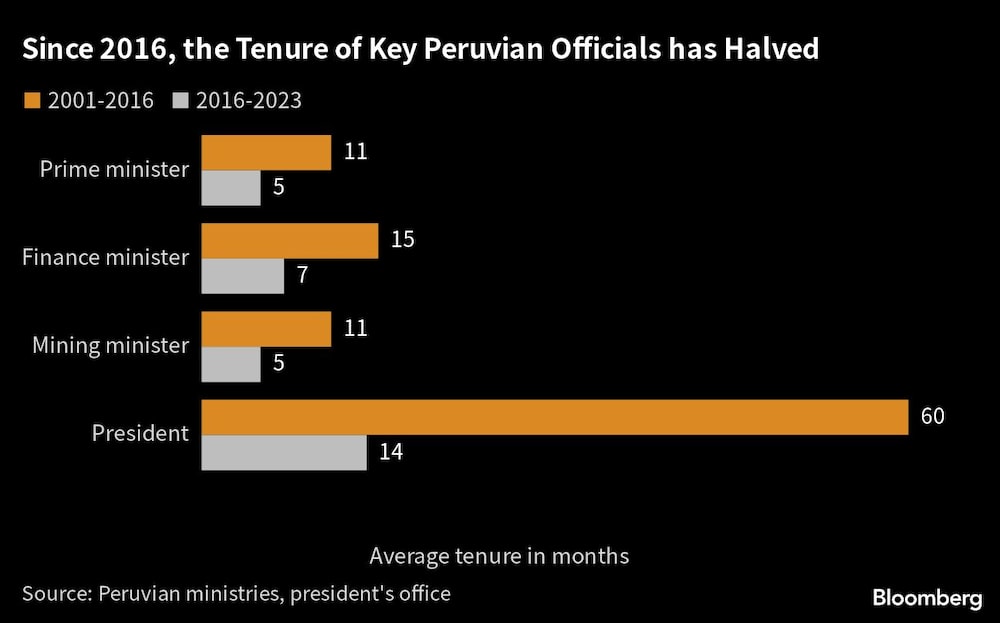
Such turnover means “the international investor loses its counterpart and needs to start over on a lot of things,” Gonzalo Tamayo, a former mining minister, told Bloomberg. Indeed: As of 2023, investment in the construction or expansion of Peruvian mines have dropped to the lowest on record. The country has some $53 billion in potential mining projects in the pipeline, but few are nearing the lucrative construction or production phases that bring with them large upfront cash investments, jobs and tax revenue.
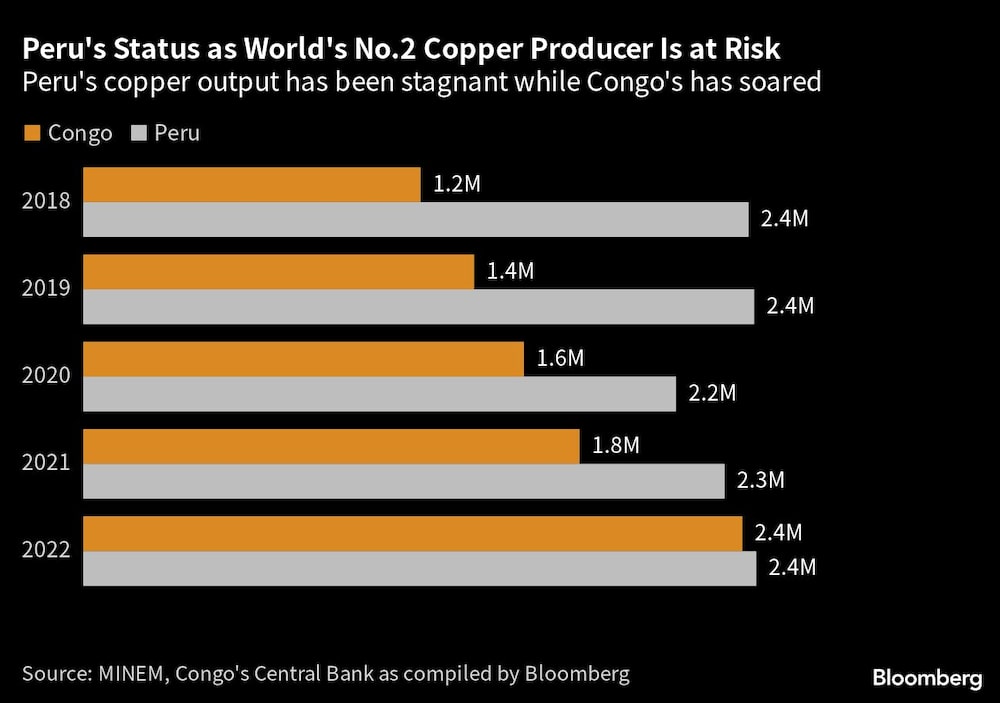
Jaime Reusche, a Moody’s analyst who covers Peru, said the country’s mining sector looks quite different from seven years ago. “The political risk and political uncertainty and now the protests have put a halt on larger mining projects,” he said.
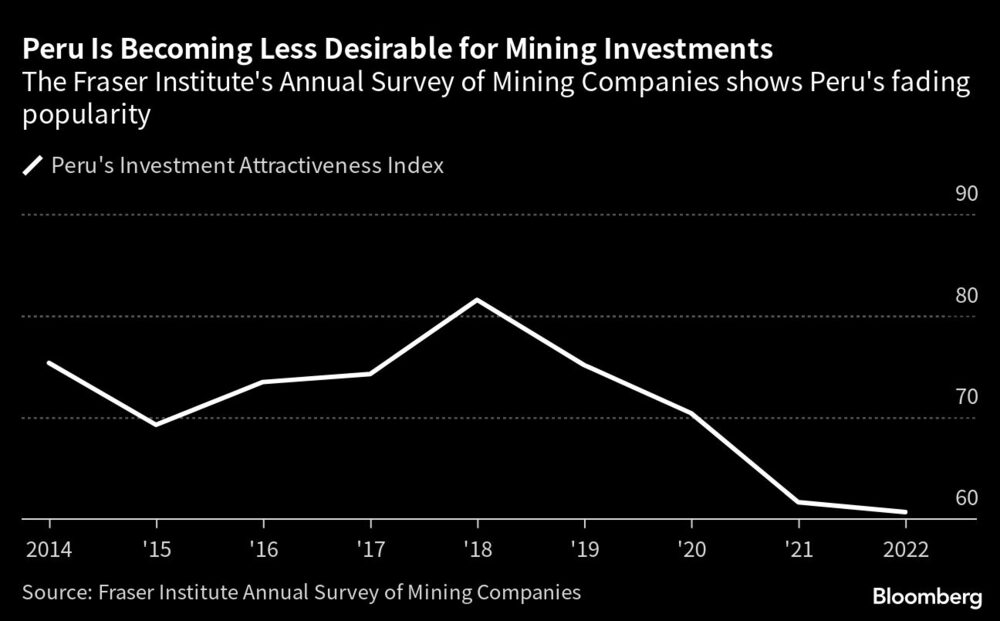
Boluarte, whose term ends in 2026, now faces Peru’s first quarterly contraction since the pandemic, spurred by this year’s civil unrest. Impeachment is always a possibility. Given recent history, who would step up? That’s a question Kuczynski has pondered: “You have to be completely cuckoo to run for president of Peru.”
--With assistance from Maria Eloisa Capurro and Juan Pablo Spinetto.
Read more on Bloomberg.com



